Sustainability Essay: Global Issues, UN Goals, and Maori Knowledge
VerifiedAdded on 2022/09/18
|13
|2739
|42
Essay
AI Summary
This essay provides a comprehensive overview of sustainability, its core principles, and its relationship to global issues and the United Nations Sustainable Development Goals (UN SDGs). It begins by defining sustainability and its three pillars: economic, social, and environmental, highlighting the importance of maintaining balance between human needs and environmental resources. The essay explores how indigenous knowledge, specifically Matauranga Maori, can influence our understanding and practice of sustainability. It then delves into the factors contributing to persistent sustainability issues, including political and economic influences. The essay further examines the UN SDGs, illustrating how they identify and address global sustainability challenges. Focusing on gender equality as a case study, it discusses the contributing factors to this issue, current progress, and the importance of addressing gender-based discrimination and violence. The essay emphasizes the need for new legal policies, equal opportunities, and the removal of harmful practices to ensure equality for women. The analysis is supported by current data on the progress of the fifth goal, illustrating the complexities of achieving sustainable development goals. This essay offers a critical examination of sustainability, global issues, and the role of indigenous knowledge and international efforts in promoting a more sustainable future.
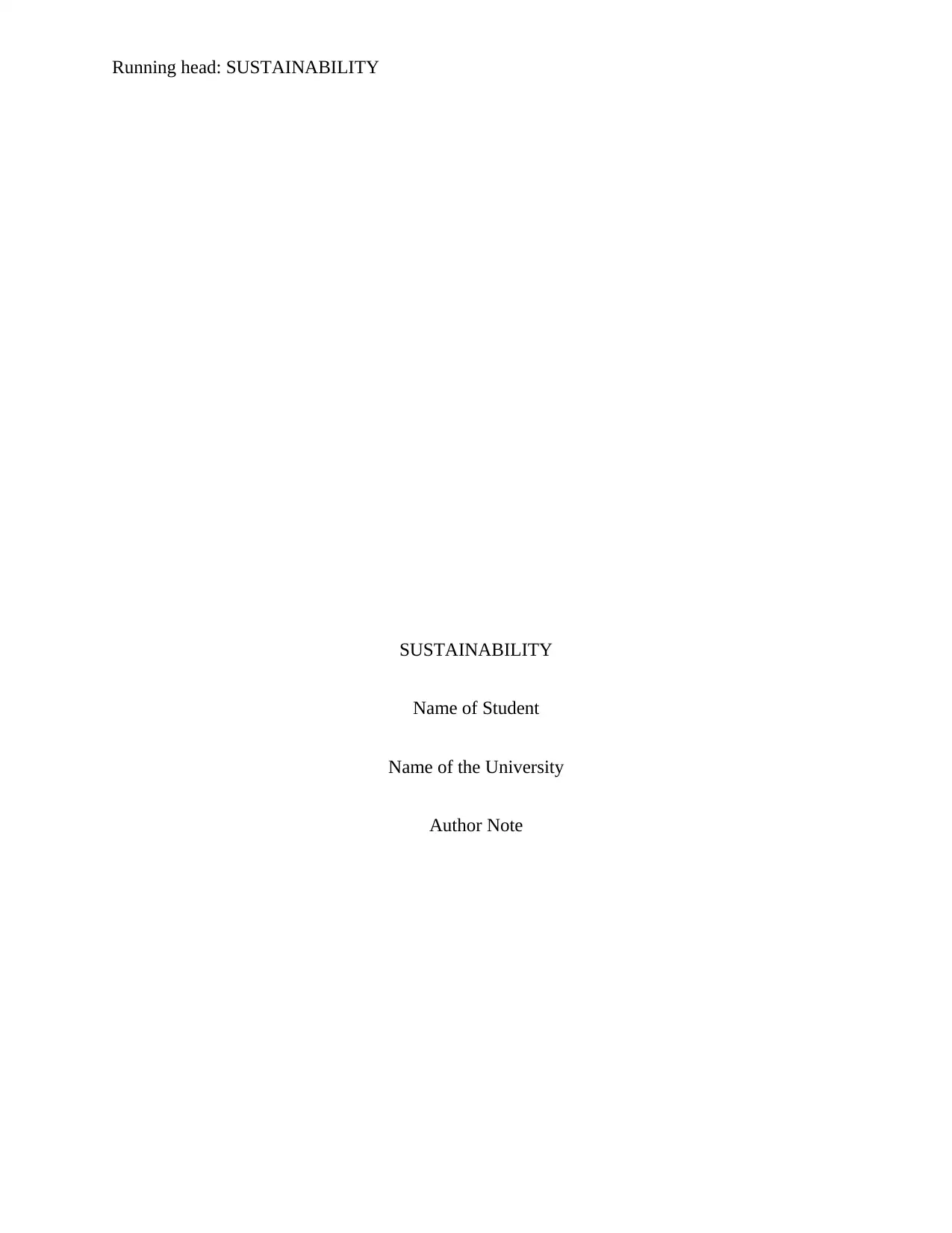
Running head: SUSTAINABILITY
SUSTAINABILITY
Name of Student
Name of the University
Author Note
SUSTAINABILITY
Name of Student
Name of the University
Author Note
Paraphrase This Document
Need a fresh take? Get an instant paraphrase of this document with our AI Paraphraser
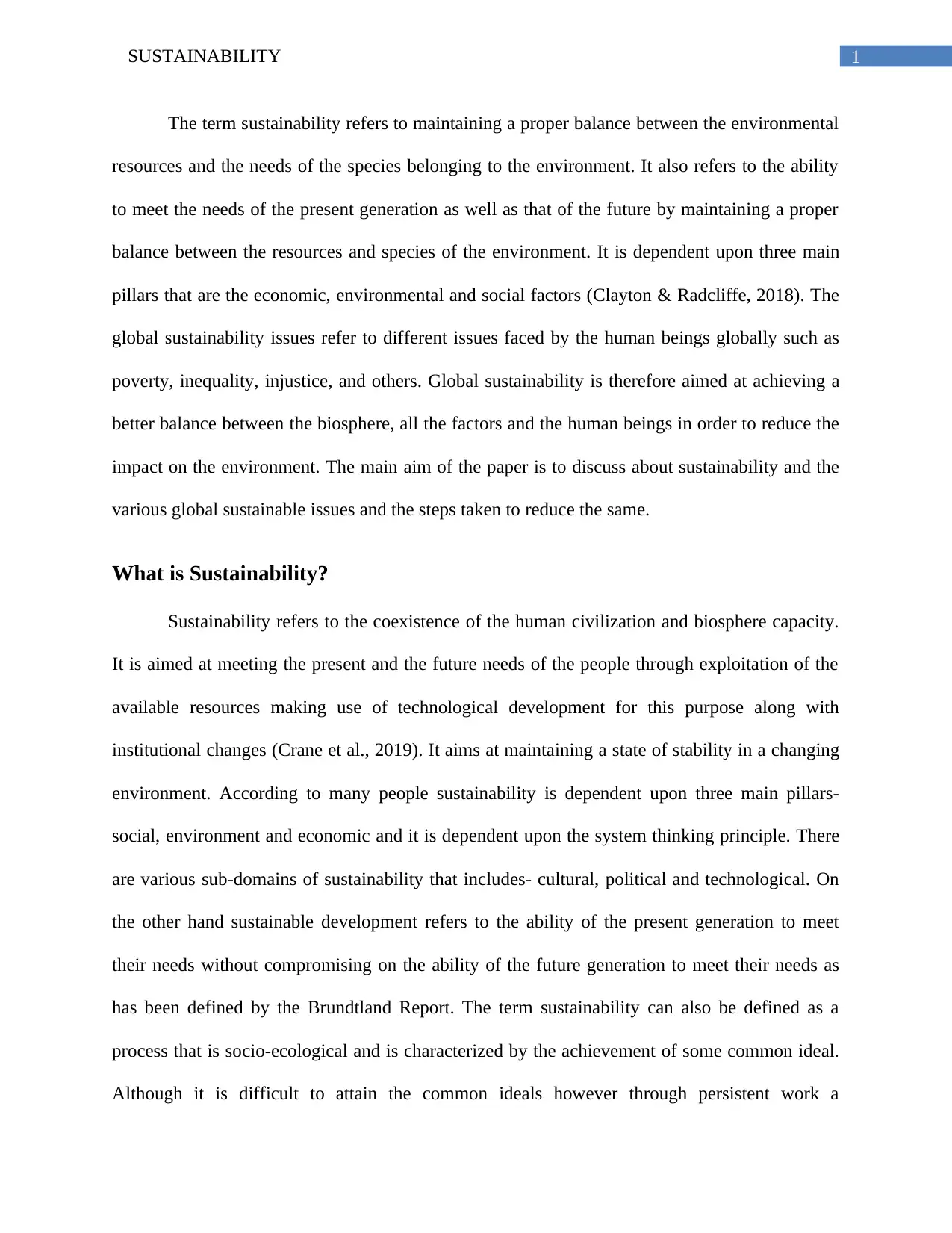
1SUSTAINABILITY
The term sustainability refers to maintaining a proper balance between the environmental
resources and the needs of the species belonging to the environment. It also refers to the ability
to meet the needs of the present generation as well as that of the future by maintaining a proper
balance between the resources and species of the environment. It is dependent upon three main
pillars that are the economic, environmental and social factors (Clayton & Radcliffe, 2018). The
global sustainability issues refer to different issues faced by the human beings globally such as
poverty, inequality, injustice, and others. Global sustainability is therefore aimed at achieving a
better balance between the biosphere, all the factors and the human beings in order to reduce the
impact on the environment. The main aim of the paper is to discuss about sustainability and the
various global sustainable issues and the steps taken to reduce the same.
What is Sustainability?
Sustainability refers to the coexistence of the human civilization and biosphere capacity.
It is aimed at meeting the present and the future needs of the people through exploitation of the
available resources making use of technological development for this purpose along with
institutional changes (Crane et al., 2019). It aims at maintaining a state of stability in a changing
environment. According to many people sustainability is dependent upon three main pillars-
social, environment and economic and it is dependent upon the system thinking principle. There
are various sub-domains of sustainability that includes- cultural, political and technological. On
the other hand sustainable development refers to the ability of the present generation to meet
their needs without compromising on the ability of the future generation to meet their needs as
has been defined by the Brundtland Report. The term sustainability can also be defined as a
process that is socio-ecological and is characterized by the achievement of some common ideal.
Although it is difficult to attain the common ideals however through persistent work a
The term sustainability refers to maintaining a proper balance between the environmental
resources and the needs of the species belonging to the environment. It also refers to the ability
to meet the needs of the present generation as well as that of the future by maintaining a proper
balance between the resources and species of the environment. It is dependent upon three main
pillars that are the economic, environmental and social factors (Clayton & Radcliffe, 2018). The
global sustainability issues refer to different issues faced by the human beings globally such as
poverty, inequality, injustice, and others. Global sustainability is therefore aimed at achieving a
better balance between the biosphere, all the factors and the human beings in order to reduce the
impact on the environment. The main aim of the paper is to discuss about sustainability and the
various global sustainable issues and the steps taken to reduce the same.
What is Sustainability?
Sustainability refers to the coexistence of the human civilization and biosphere capacity.
It is aimed at meeting the present and the future needs of the people through exploitation of the
available resources making use of technological development for this purpose along with
institutional changes (Crane et al., 2019). It aims at maintaining a state of stability in a changing
environment. According to many people sustainability is dependent upon three main pillars-
social, environment and economic and it is dependent upon the system thinking principle. There
are various sub-domains of sustainability that includes- cultural, political and technological. On
the other hand sustainable development refers to the ability of the present generation to meet
their needs without compromising on the ability of the future generation to meet their needs as
has been defined by the Brundtland Report. The term sustainability can also be defined as a
process that is socio-ecological and is characterized by the achievement of some common ideal.
Although it is difficult to attain the common ideals however through persistent work a
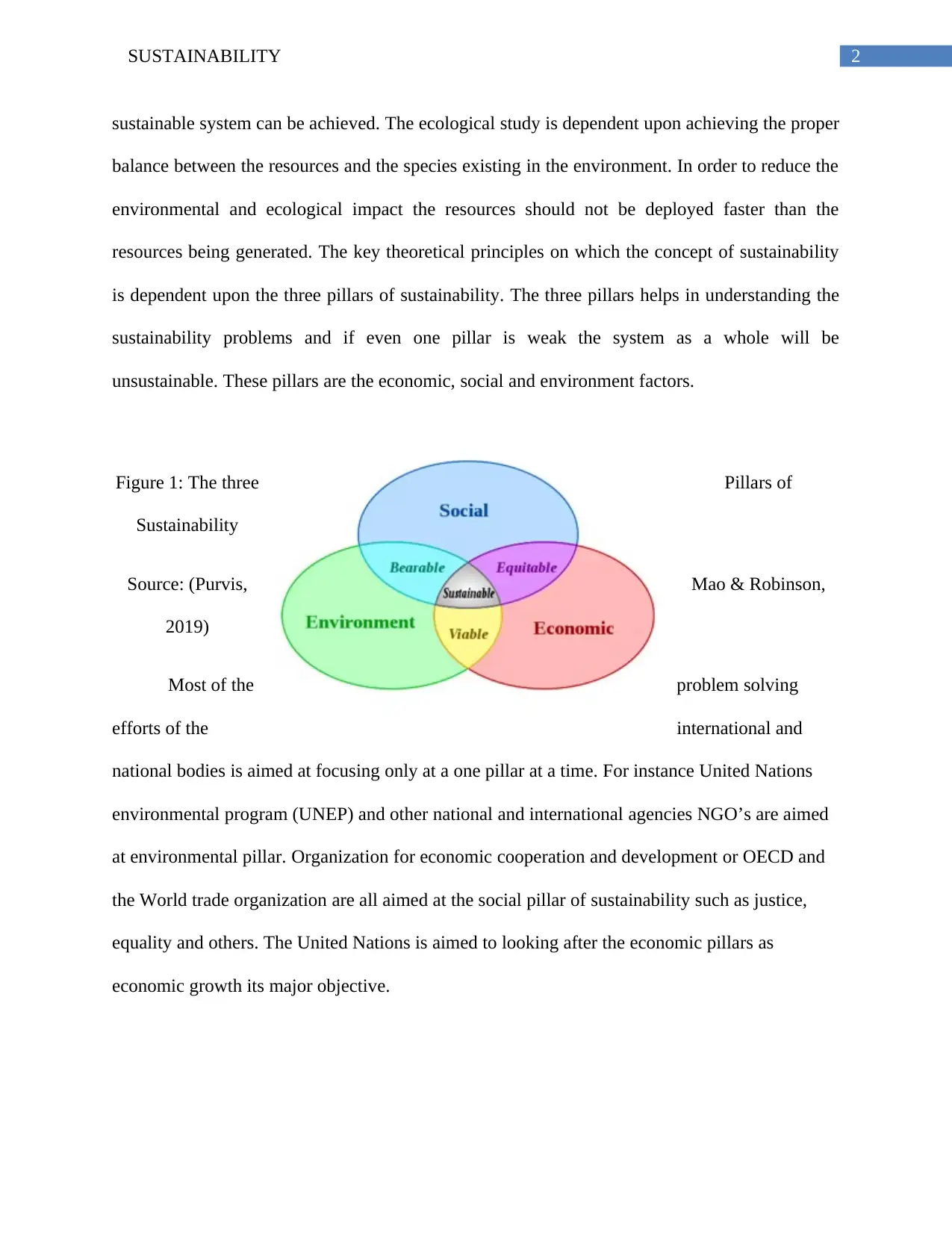
2SUSTAINABILITY
sustainable system can be achieved. The ecological study is dependent upon achieving the proper
balance between the resources and the species existing in the environment. In order to reduce the
environmental and ecological impact the resources should not be deployed faster than the
resources being generated. The key theoretical principles on which the concept of sustainability
is dependent upon the three pillars of sustainability. The three pillars helps in understanding the
sustainability problems and if even one pillar is weak the system as a whole will be
unsustainable. These pillars are the economic, social and environment factors.
Figure 1: The three Pillars of
Sustainability
Source: (Purvis, Mao & Robinson,
2019)
Most of the problem solving
efforts of the international and
national bodies is aimed at focusing only at a one pillar at a time. For instance United Nations
environmental program (UNEP) and other national and international agencies NGO’s are aimed
at environmental pillar. Organization for economic cooperation and development or OECD and
the World trade organization are all aimed at the social pillar of sustainability such as justice,
equality and others. The United Nations is aimed to looking after the economic pillars as
economic growth its major objective.
sustainable system can be achieved. The ecological study is dependent upon achieving the proper
balance between the resources and the species existing in the environment. In order to reduce the
environmental and ecological impact the resources should not be deployed faster than the
resources being generated. The key theoretical principles on which the concept of sustainability
is dependent upon the three pillars of sustainability. The three pillars helps in understanding the
sustainability problems and if even one pillar is weak the system as a whole will be
unsustainable. These pillars are the economic, social and environment factors.
Figure 1: The three Pillars of
Sustainability
Source: (Purvis, Mao & Robinson,
2019)
Most of the problem solving
efforts of the international and
national bodies is aimed at focusing only at a one pillar at a time. For instance United Nations
environmental program (UNEP) and other national and international agencies NGO’s are aimed
at environmental pillar. Organization for economic cooperation and development or OECD and
the World trade organization are all aimed at the social pillar of sustainability such as justice,
equality and others. The United Nations is aimed to looking after the economic pillars as
economic growth its major objective.
⊘ This is a preview!⊘
Do you want full access?
Subscribe today to unlock all pages.

Trusted by 1+ million students worldwide
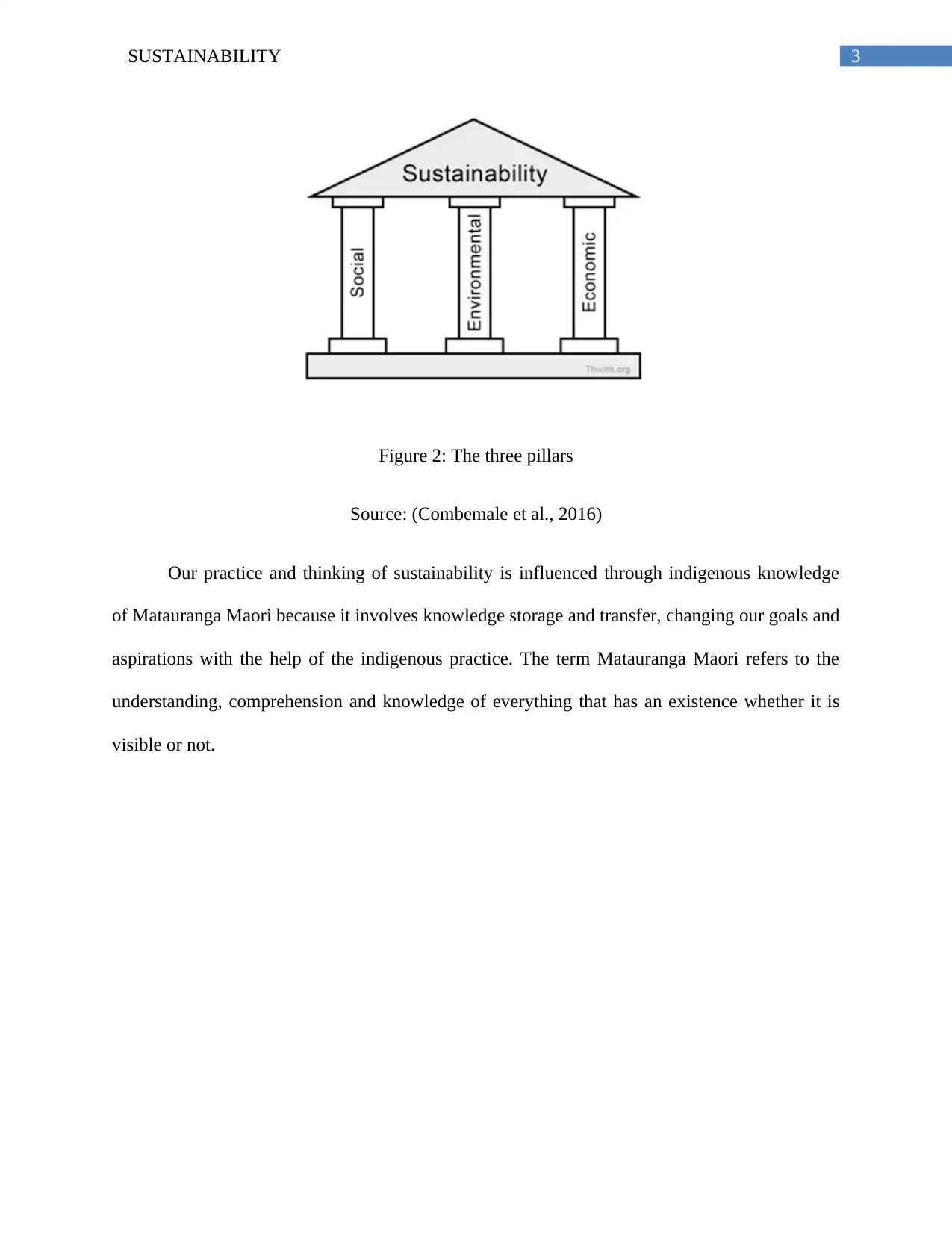
3SUSTAINABILITY
Figure 2: The three pillars
Source: (Combemale et al., 2016)
Our practice and thinking of sustainability is influenced through indigenous knowledge
of Matauranga Maori because it involves knowledge storage and transfer, changing our goals and
aspirations with the help of the indigenous practice. The term Matauranga Maori refers to the
understanding, comprehension and knowledge of everything that has an existence whether it is
visible or not.
Figure 2: The three pillars
Source: (Combemale et al., 2016)
Our practice and thinking of sustainability is influenced through indigenous knowledge
of Matauranga Maori because it involves knowledge storage and transfer, changing our goals and
aspirations with the help of the indigenous practice. The term Matauranga Maori refers to the
understanding, comprehension and knowledge of everything that has an existence whether it is
visible or not.
Paraphrase This Document
Need a fresh take? Get an instant paraphrase of this document with our AI Paraphraser
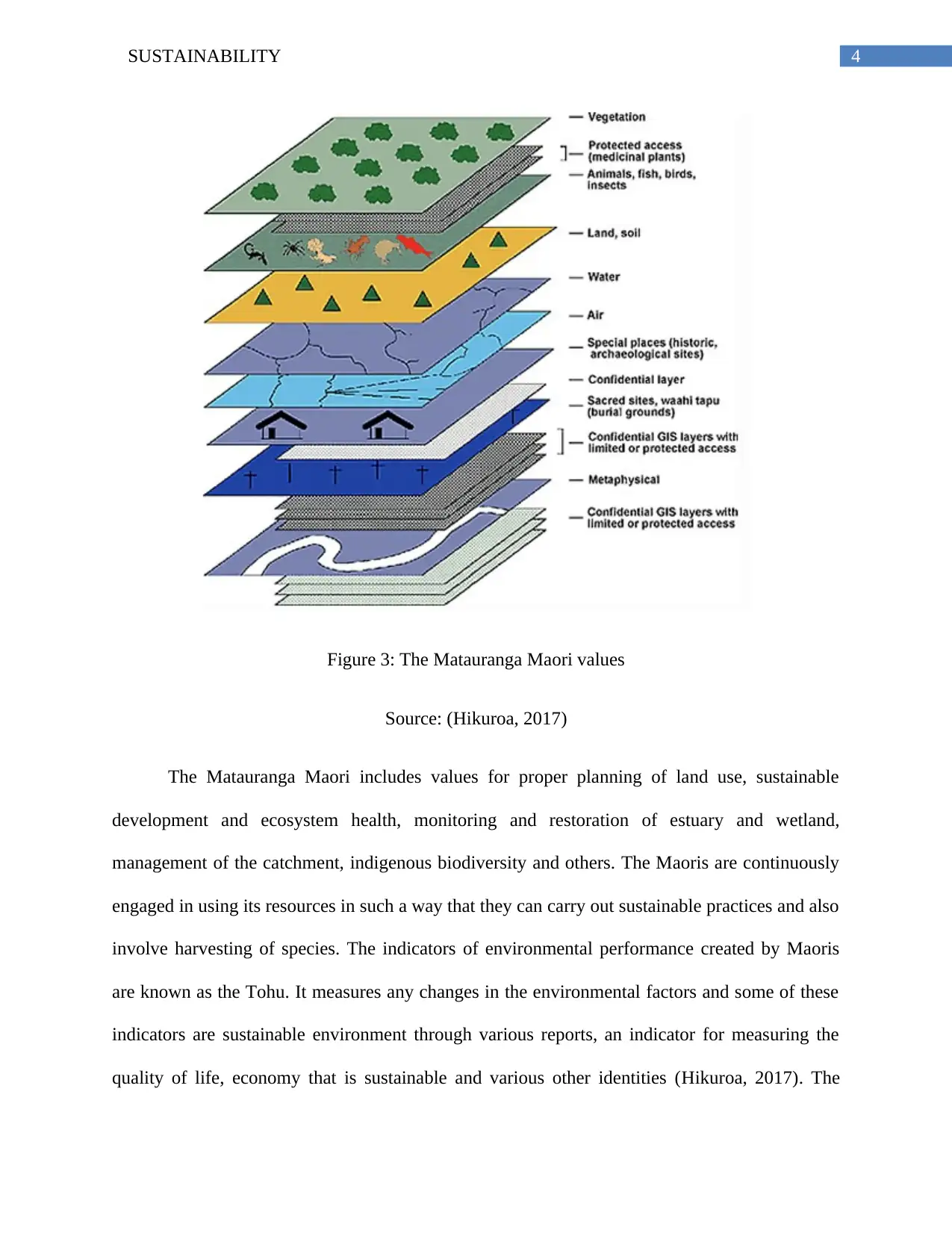
4SUSTAINABILITY
Figure 3: The Matauranga Maori values
Source: (Hikuroa, 2017)
The Matauranga Maori includes values for proper planning of land use, sustainable
development and ecosystem health, monitoring and restoration of estuary and wetland,
management of the catchment, indigenous biodiversity and others. The Maoris are continuously
engaged in using its resources in such a way that they can carry out sustainable practices and also
involve harvesting of species. The indicators of environmental performance created by Maoris
are known as the Tohu. It measures any changes in the environmental factors and some of these
indicators are sustainable environment through various reports, an indicator for measuring the
quality of life, economy that is sustainable and various other identities (Hikuroa, 2017). The
Figure 3: The Matauranga Maori values
Source: (Hikuroa, 2017)
The Matauranga Maori includes values for proper planning of land use, sustainable
development and ecosystem health, monitoring and restoration of estuary and wetland,
management of the catchment, indigenous biodiversity and others. The Maoris are continuously
engaged in using its resources in such a way that they can carry out sustainable practices and also
involve harvesting of species. The indicators of environmental performance created by Maoris
are known as the Tohu. It measures any changes in the environmental factors and some of these
indicators are sustainable environment through various reports, an indicator for measuring the
quality of life, economy that is sustainable and various other identities (Hikuroa, 2017). The
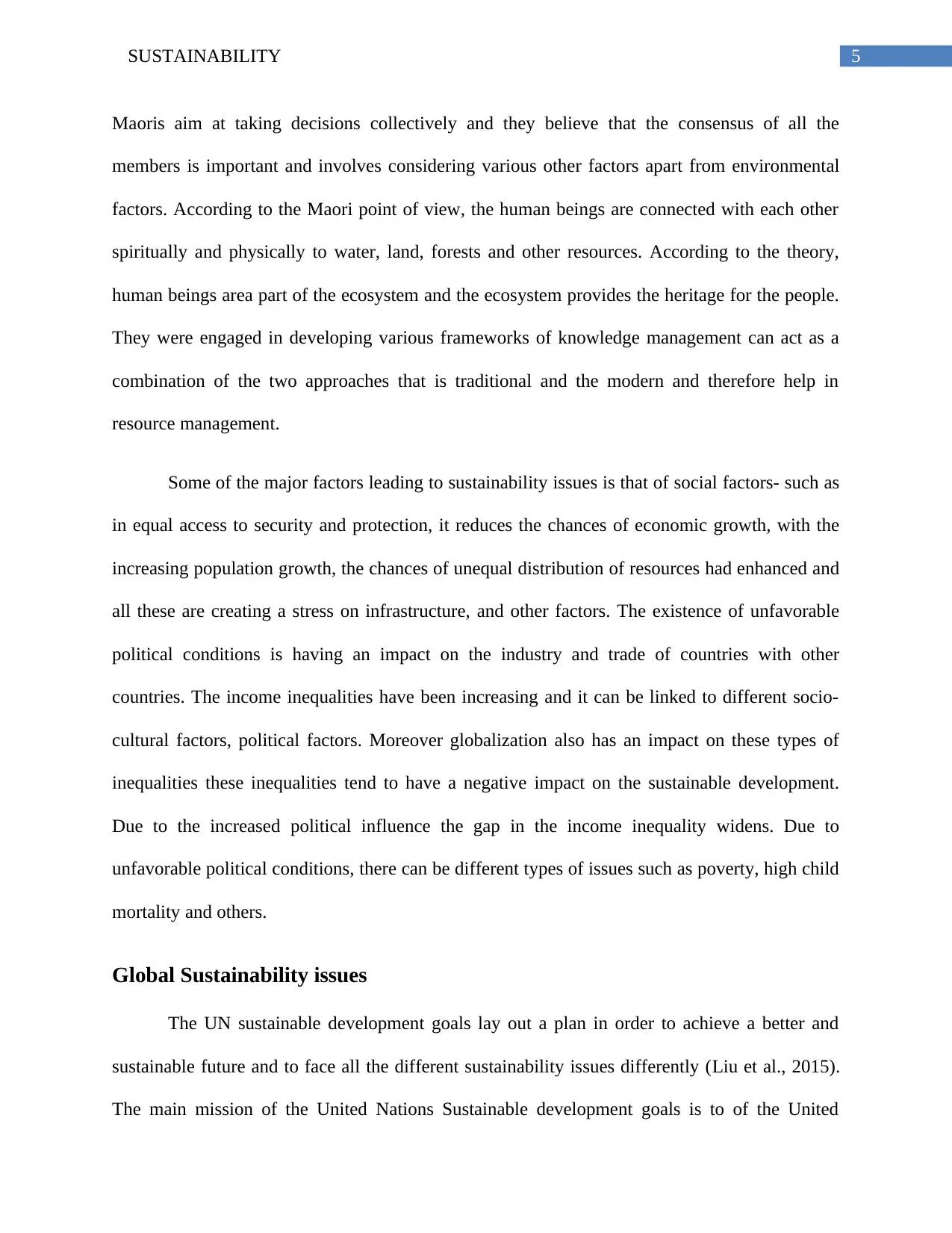
5SUSTAINABILITY
Maoris aim at taking decisions collectively and they believe that the consensus of all the
members is important and involves considering various other factors apart from environmental
factors. According to the Maori point of view, the human beings are connected with each other
spiritually and physically to water, land, forests and other resources. According to the theory,
human beings area part of the ecosystem and the ecosystem provides the heritage for the people.
They were engaged in developing various frameworks of knowledge management can act as a
combination of the two approaches that is traditional and the modern and therefore help in
resource management.
Some of the major factors leading to sustainability issues is that of social factors- such as
in equal access to security and protection, it reduces the chances of economic growth, with the
increasing population growth, the chances of unequal distribution of resources had enhanced and
all these are creating a stress on infrastructure, and other factors. The existence of unfavorable
political conditions is having an impact on the industry and trade of countries with other
countries. The income inequalities have been increasing and it can be linked to different socio-
cultural factors, political factors. Moreover globalization also has an impact on these types of
inequalities these inequalities tend to have a negative impact on the sustainable development.
Due to the increased political influence the gap in the income inequality widens. Due to
unfavorable political conditions, there can be different types of issues such as poverty, high child
mortality and others.
Global Sustainability issues
The UN sustainable development goals lay out a plan in order to achieve a better and
sustainable future and to face all the different sustainability issues differently (Liu et al., 2015).
The main mission of the United Nations Sustainable development goals is to of the United
Maoris aim at taking decisions collectively and they believe that the consensus of all the
members is important and involves considering various other factors apart from environmental
factors. According to the Maori point of view, the human beings are connected with each other
spiritually and physically to water, land, forests and other resources. According to the theory,
human beings area part of the ecosystem and the ecosystem provides the heritage for the people.
They were engaged in developing various frameworks of knowledge management can act as a
combination of the two approaches that is traditional and the modern and therefore help in
resource management.
Some of the major factors leading to sustainability issues is that of social factors- such as
in equal access to security and protection, it reduces the chances of economic growth, with the
increasing population growth, the chances of unequal distribution of resources had enhanced and
all these are creating a stress on infrastructure, and other factors. The existence of unfavorable
political conditions is having an impact on the industry and trade of countries with other
countries. The income inequalities have been increasing and it can be linked to different socio-
cultural factors, political factors. Moreover globalization also has an impact on these types of
inequalities these inequalities tend to have a negative impact on the sustainable development.
Due to the increased political influence the gap in the income inequality widens. Due to
unfavorable political conditions, there can be different types of issues such as poverty, high child
mortality and others.
Global Sustainability issues
The UN sustainable development goals lay out a plan in order to achieve a better and
sustainable future and to face all the different sustainability issues differently (Liu et al., 2015).
The main mission of the United Nations Sustainable development goals is to of the United
⊘ This is a preview!⊘
Do you want full access?
Subscribe today to unlock all pages.

Trusted by 1+ million students worldwide
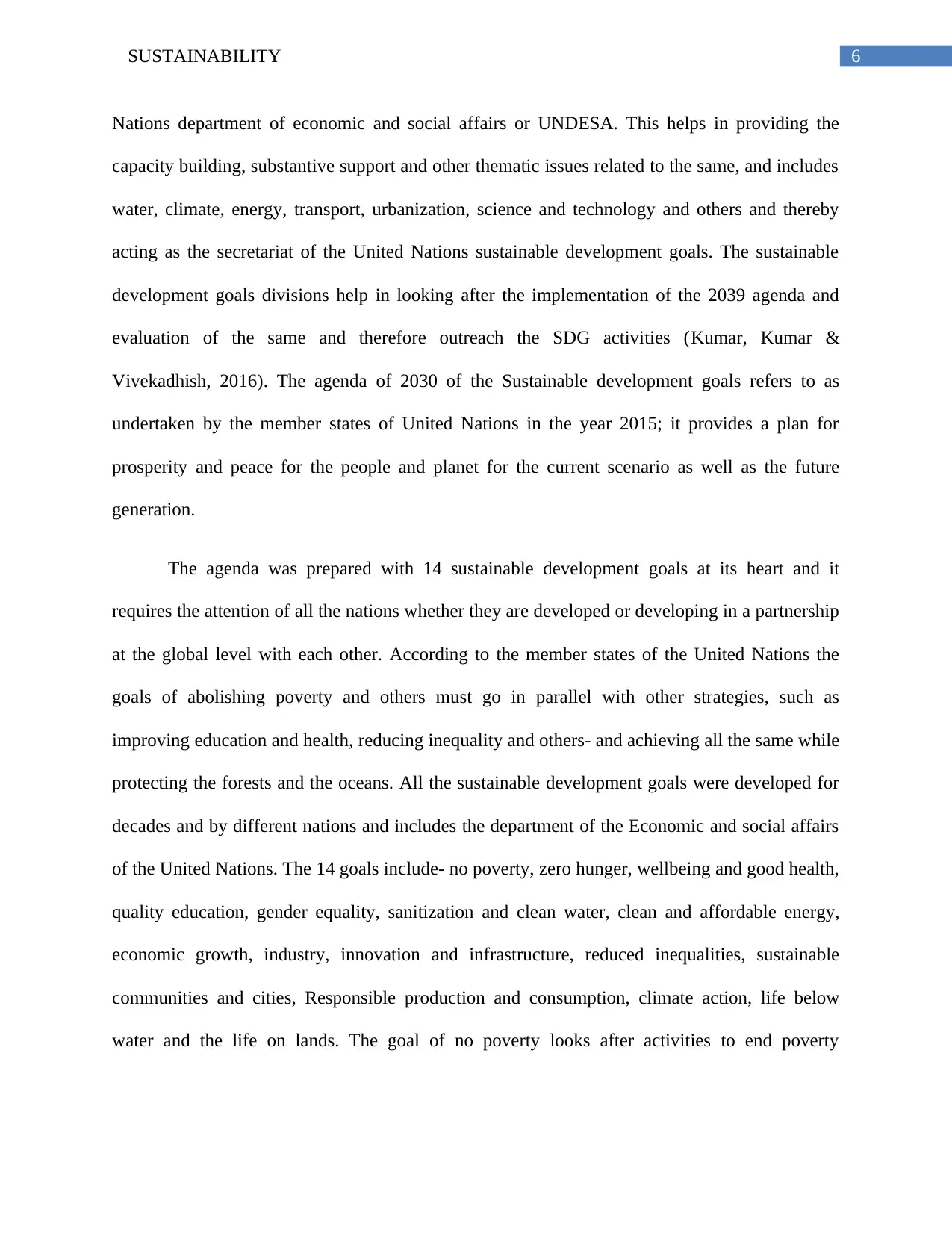
6SUSTAINABILITY
Nations department of economic and social affairs or UNDESA. This helps in providing the
capacity building, substantive support and other thematic issues related to the same, and includes
water, climate, energy, transport, urbanization, science and technology and others and thereby
acting as the secretariat of the United Nations sustainable development goals. The sustainable
development goals divisions help in looking after the implementation of the 2039 agenda and
evaluation of the same and therefore outreach the SDG activities (Kumar, Kumar &
Vivekadhish, 2016). The agenda of 2030 of the Sustainable development goals refers to as
undertaken by the member states of United Nations in the year 2015; it provides a plan for
prosperity and peace for the people and planet for the current scenario as well as the future
generation.
The agenda was prepared with 14 sustainable development goals at its heart and it
requires the attention of all the nations whether they are developed or developing in a partnership
at the global level with each other. According to the member states of the United Nations the
goals of abolishing poverty and others must go in parallel with other strategies, such as
improving education and health, reducing inequality and others- and achieving all the same while
protecting the forests and the oceans. All the sustainable development goals were developed for
decades and by different nations and includes the department of the Economic and social affairs
of the United Nations. The 14 goals include- no poverty, zero hunger, wellbeing and good health,
quality education, gender equality, sanitization and clean water, clean and affordable energy,
economic growth, industry, innovation and infrastructure, reduced inequalities, sustainable
communities and cities, Responsible production and consumption, climate action, life below
water and the life on lands. The goal of no poverty looks after activities to end poverty
Nations department of economic and social affairs or UNDESA. This helps in providing the
capacity building, substantive support and other thematic issues related to the same, and includes
water, climate, energy, transport, urbanization, science and technology and others and thereby
acting as the secretariat of the United Nations sustainable development goals. The sustainable
development goals divisions help in looking after the implementation of the 2039 agenda and
evaluation of the same and therefore outreach the SDG activities (Kumar, Kumar &
Vivekadhish, 2016). The agenda of 2030 of the Sustainable development goals refers to as
undertaken by the member states of United Nations in the year 2015; it provides a plan for
prosperity and peace for the people and planet for the current scenario as well as the future
generation.
The agenda was prepared with 14 sustainable development goals at its heart and it
requires the attention of all the nations whether they are developed or developing in a partnership
at the global level with each other. According to the member states of the United Nations the
goals of abolishing poverty and others must go in parallel with other strategies, such as
improving education and health, reducing inequality and others- and achieving all the same while
protecting the forests and the oceans. All the sustainable development goals were developed for
decades and by different nations and includes the department of the Economic and social affairs
of the United Nations. The 14 goals include- no poverty, zero hunger, wellbeing and good health,
quality education, gender equality, sanitization and clean water, clean and affordable energy,
economic growth, industry, innovation and infrastructure, reduced inequalities, sustainable
communities and cities, Responsible production and consumption, climate action, life below
water and the life on lands. The goal of no poverty looks after activities to end poverty
Paraphrase This Document
Need a fresh take? Get an instant paraphrase of this document with our AI Paraphraser
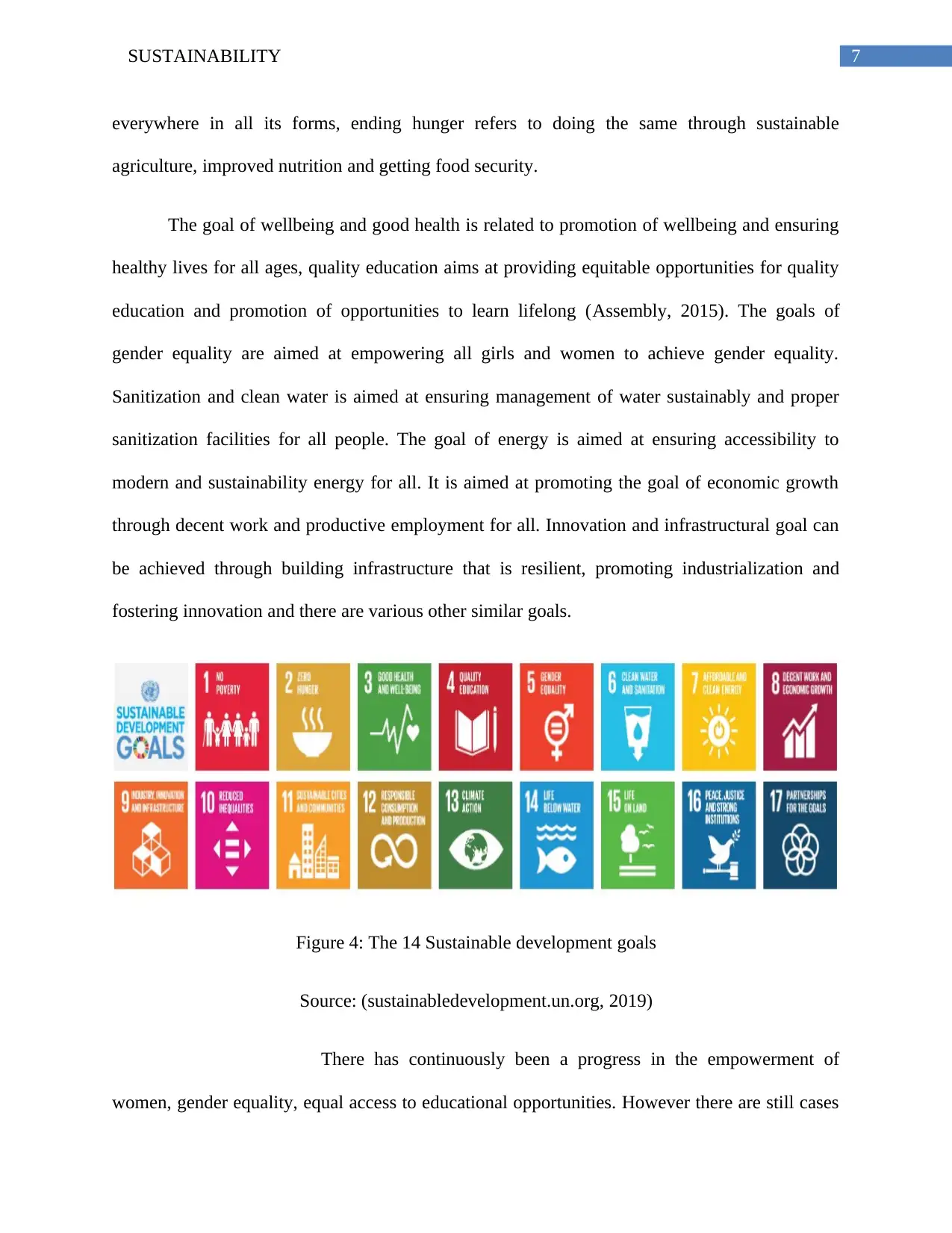
7SUSTAINABILITY
everywhere in all its forms, ending hunger refers to doing the same through sustainable
agriculture, improved nutrition and getting food security.
The goal of wellbeing and good health is related to promotion of wellbeing and ensuring
healthy lives for all ages, quality education aims at providing equitable opportunities for quality
education and promotion of opportunities to learn lifelong (Assembly, 2015). The goals of
gender equality are aimed at empowering all girls and women to achieve gender equality.
Sanitization and clean water is aimed at ensuring management of water sustainably and proper
sanitization facilities for all people. The goal of energy is aimed at ensuring accessibility to
modern and sustainability energy for all. It is aimed at promoting the goal of economic growth
through decent work and productive employment for all. Innovation and infrastructural goal can
be achieved through building infrastructure that is resilient, promoting industrialization and
fostering innovation and there are various other similar goals.
Figure 4: The 14 Sustainable development goals
Source: (sustainabledevelopment.un.org, 2019)
There has continuously been a progress in the empowerment of
women, gender equality, equal access to educational opportunities. However there are still cases
everywhere in all its forms, ending hunger refers to doing the same through sustainable
agriculture, improved nutrition and getting food security.
The goal of wellbeing and good health is related to promotion of wellbeing and ensuring
healthy lives for all ages, quality education aims at providing equitable opportunities for quality
education and promotion of opportunities to learn lifelong (Assembly, 2015). The goals of
gender equality are aimed at empowering all girls and women to achieve gender equality.
Sanitization and clean water is aimed at ensuring management of water sustainably and proper
sanitization facilities for all people. The goal of energy is aimed at ensuring accessibility to
modern and sustainability energy for all. It is aimed at promoting the goal of economic growth
through decent work and productive employment for all. Innovation and infrastructural goal can
be achieved through building infrastructure that is resilient, promoting industrialization and
fostering innovation and there are various other similar goals.
Figure 4: The 14 Sustainable development goals
Source: (sustainabledevelopment.un.org, 2019)
There has continuously been a progress in the empowerment of
women, gender equality, equal access to educational opportunities. However there are still cases
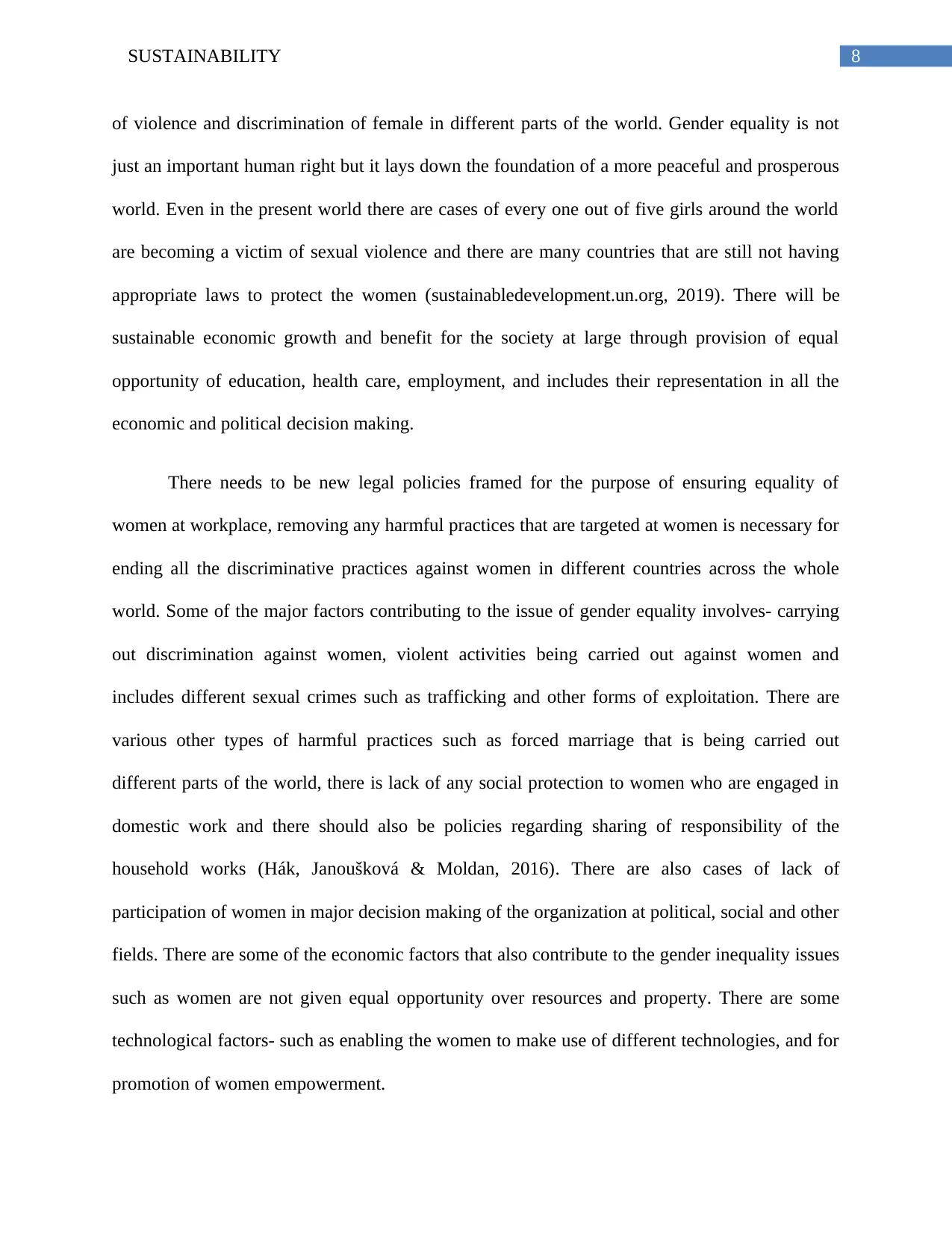
8SUSTAINABILITY
of violence and discrimination of female in different parts of the world. Gender equality is not
just an important human right but it lays down the foundation of a more peaceful and prosperous
world. Even in the present world there are cases of every one out of five girls around the world
are becoming a victim of sexual violence and there are many countries that are still not having
appropriate laws to protect the women (sustainabledevelopment.un.org, 2019). There will be
sustainable economic growth and benefit for the society at large through provision of equal
opportunity of education, health care, employment, and includes their representation in all the
economic and political decision making.
There needs to be new legal policies framed for the purpose of ensuring equality of
women at workplace, removing any harmful practices that are targeted at women is necessary for
ending all the discriminative practices against women in different countries across the whole
world. Some of the major factors contributing to the issue of gender equality involves- carrying
out discrimination against women, violent activities being carried out against women and
includes different sexual crimes such as trafficking and other forms of exploitation. There are
various other types of harmful practices such as forced marriage that is being carried out
different parts of the world, there is lack of any social protection to women who are engaged in
domestic work and there should also be policies regarding sharing of responsibility of the
household works (Hák, Janoušková & Moldan, 2016). There are also cases of lack of
participation of women in major decision making of the organization at political, social and other
fields. There are some of the economic factors that also contribute to the gender inequality issues
such as women are not given equal opportunity over resources and property. There are some
technological factors- such as enabling the women to make use of different technologies, and for
promotion of women empowerment.
of violence and discrimination of female in different parts of the world. Gender equality is not
just an important human right but it lays down the foundation of a more peaceful and prosperous
world. Even in the present world there are cases of every one out of five girls around the world
are becoming a victim of sexual violence and there are many countries that are still not having
appropriate laws to protect the women (sustainabledevelopment.un.org, 2019). There will be
sustainable economic growth and benefit for the society at large through provision of equal
opportunity of education, health care, employment, and includes their representation in all the
economic and political decision making.
There needs to be new legal policies framed for the purpose of ensuring equality of
women at workplace, removing any harmful practices that are targeted at women is necessary for
ending all the discriminative practices against women in different countries across the whole
world. Some of the major factors contributing to the issue of gender equality involves- carrying
out discrimination against women, violent activities being carried out against women and
includes different sexual crimes such as trafficking and other forms of exploitation. There are
various other types of harmful practices such as forced marriage that is being carried out
different parts of the world, there is lack of any social protection to women who are engaged in
domestic work and there should also be policies regarding sharing of responsibility of the
household works (Hák, Janoušková & Moldan, 2016). There are also cases of lack of
participation of women in major decision making of the organization at political, social and other
fields. There are some of the economic factors that also contribute to the gender inequality issues
such as women are not given equal opportunity over resources and property. There are some
technological factors- such as enabling the women to make use of different technologies, and for
promotion of women empowerment.
⊘ This is a preview!⊘
Do you want full access?
Subscribe today to unlock all pages.

Trusted by 1+ million students worldwide
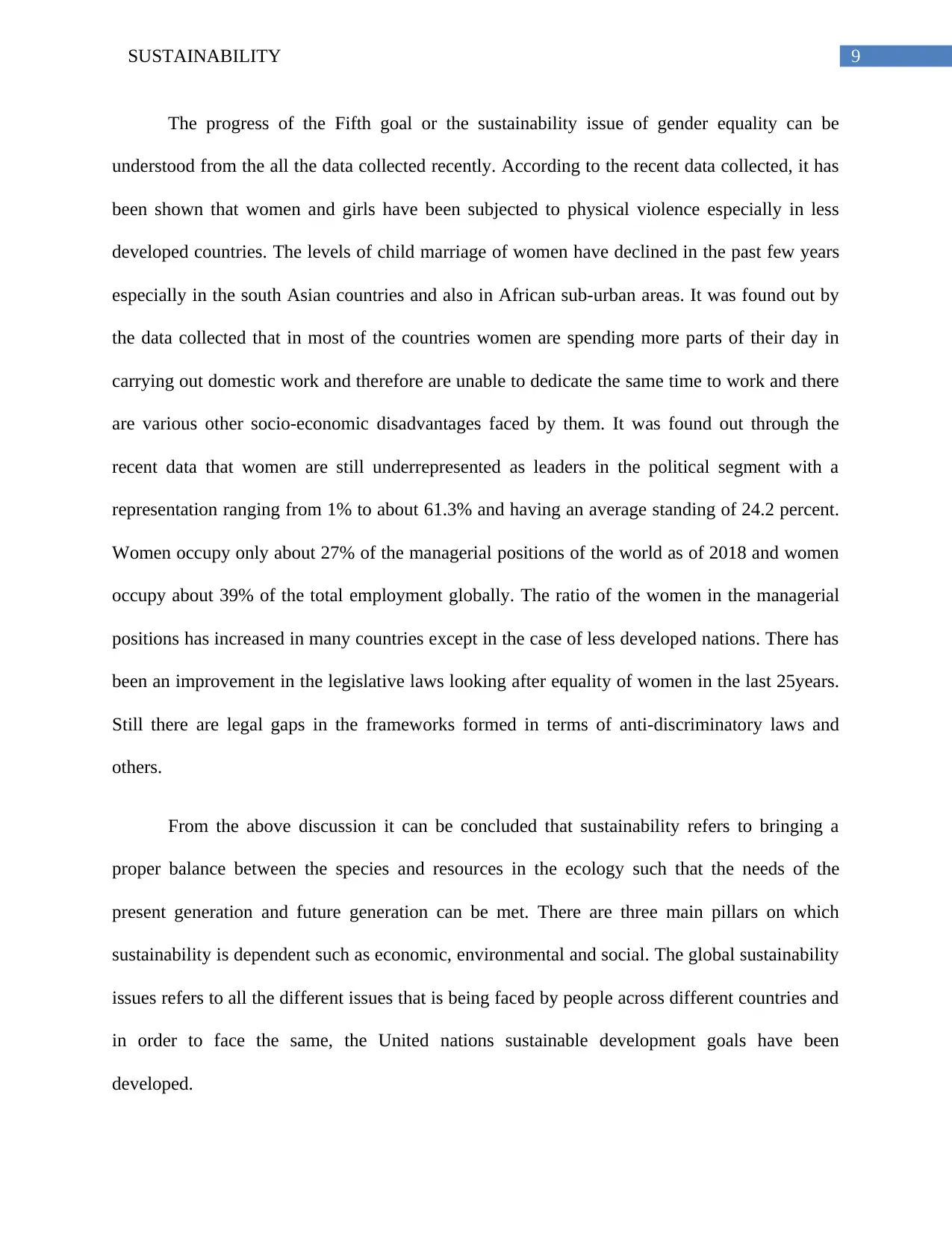
9SUSTAINABILITY
The progress of the Fifth goal or the sustainability issue of gender equality can be
understood from the all the data collected recently. According to the recent data collected, it has
been shown that women and girls have been subjected to physical violence especially in less
developed countries. The levels of child marriage of women have declined in the past few years
especially in the south Asian countries and also in African sub-urban areas. It was found out by
the data collected that in most of the countries women are spending more parts of their day in
carrying out domestic work and therefore are unable to dedicate the same time to work and there
are various other socio-economic disadvantages faced by them. It was found out through the
recent data that women are still underrepresented as leaders in the political segment with a
representation ranging from 1% to about 61.3% and having an average standing of 24.2 percent.
Women occupy only about 27% of the managerial positions of the world as of 2018 and women
occupy about 39% of the total employment globally. The ratio of the women in the managerial
positions has increased in many countries except in the case of less developed nations. There has
been an improvement in the legislative laws looking after equality of women in the last 25years.
Still there are legal gaps in the frameworks formed in terms of anti-discriminatory laws and
others.
From the above discussion it can be concluded that sustainability refers to bringing a
proper balance between the species and resources in the ecology such that the needs of the
present generation and future generation can be met. There are three main pillars on which
sustainability is dependent such as economic, environmental and social. The global sustainability
issues refers to all the different issues that is being faced by people across different countries and
in order to face the same, the United nations sustainable development goals have been
developed.
The progress of the Fifth goal or the sustainability issue of gender equality can be
understood from the all the data collected recently. According to the recent data collected, it has
been shown that women and girls have been subjected to physical violence especially in less
developed countries. The levels of child marriage of women have declined in the past few years
especially in the south Asian countries and also in African sub-urban areas. It was found out by
the data collected that in most of the countries women are spending more parts of their day in
carrying out domestic work and therefore are unable to dedicate the same time to work and there
are various other socio-economic disadvantages faced by them. It was found out through the
recent data that women are still underrepresented as leaders in the political segment with a
representation ranging from 1% to about 61.3% and having an average standing of 24.2 percent.
Women occupy only about 27% of the managerial positions of the world as of 2018 and women
occupy about 39% of the total employment globally. The ratio of the women in the managerial
positions has increased in many countries except in the case of less developed nations. There has
been an improvement in the legislative laws looking after equality of women in the last 25years.
Still there are legal gaps in the frameworks formed in terms of anti-discriminatory laws and
others.
From the above discussion it can be concluded that sustainability refers to bringing a
proper balance between the species and resources in the ecology such that the needs of the
present generation and future generation can be met. There are three main pillars on which
sustainability is dependent such as economic, environmental and social. The global sustainability
issues refers to all the different issues that is being faced by people across different countries and
in order to face the same, the United nations sustainable development goals have been
developed.
Paraphrase This Document
Need a fresh take? Get an instant paraphrase of this document with our AI Paraphraser

10SUSTAINABILITY
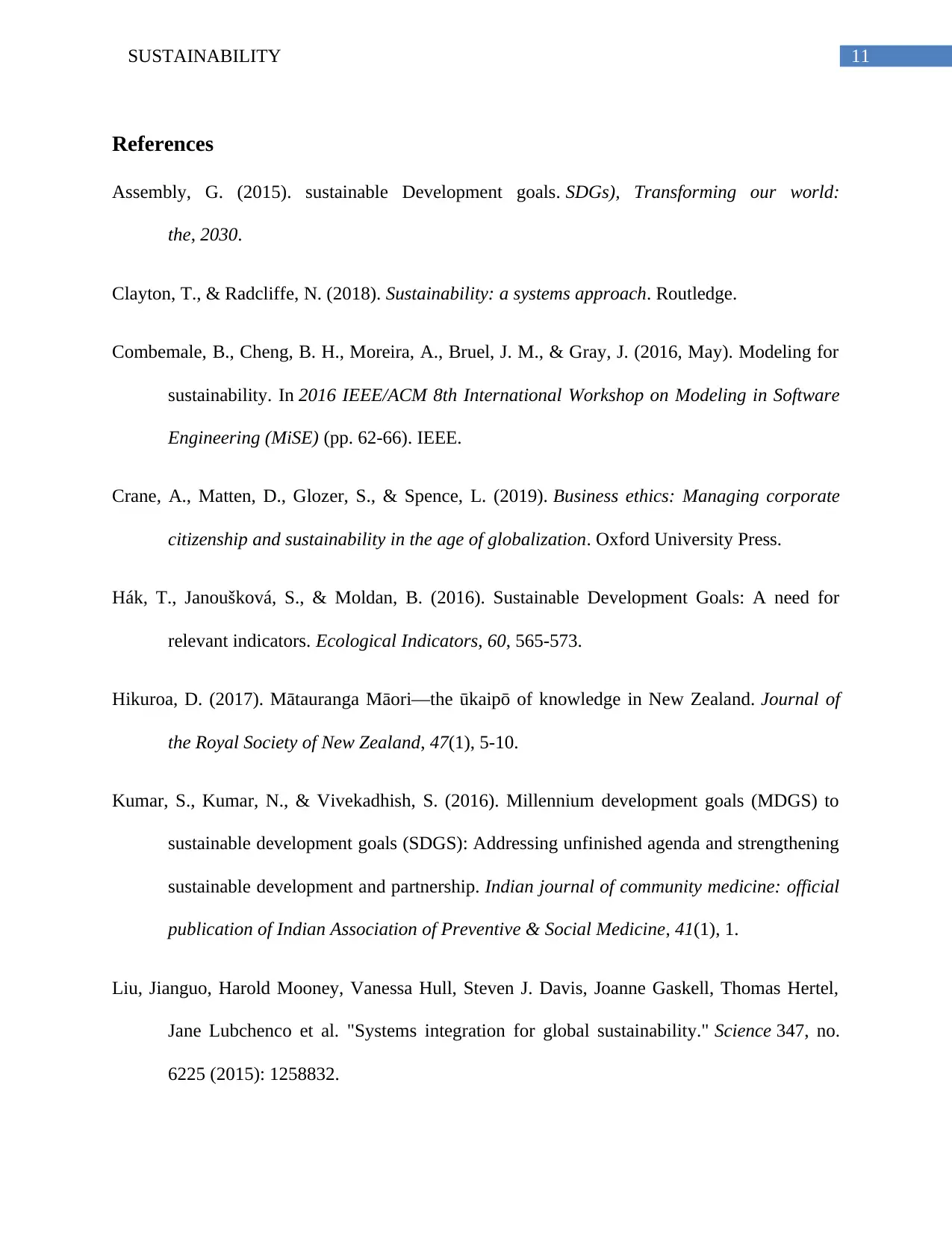
11SUSTAINABILITY
References
Assembly, G. (2015). sustainable Development goals. SDGs), Transforming our world:
the, 2030.
Clayton, T., & Radcliffe, N. (2018). Sustainability: a systems approach. Routledge.
Combemale, B., Cheng, B. H., Moreira, A., Bruel, J. M., & Gray, J. (2016, May). Modeling for
sustainability. In 2016 IEEE/ACM 8th International Workshop on Modeling in Software
Engineering (MiSE) (pp. 62-66). IEEE.
Crane, A., Matten, D., Glozer, S., & Spence, L. (2019). Business ethics: Managing corporate
citizenship and sustainability in the age of globalization. Oxford University Press.
Hák, T., Janoušková, S., & Moldan, B. (2016). Sustainable Development Goals: A need for
relevant indicators. Ecological Indicators, 60, 565-573.
Hikuroa, D. (2017). Mātauranga Māori—the ūkaipō of knowledge in New Zealand. Journal of
the Royal Society of New Zealand, 47(1), 5-10.
Kumar, S., Kumar, N., & Vivekadhish, S. (2016). Millennium development goals (MDGS) to
sustainable development goals (SDGS): Addressing unfinished agenda and strengthening
sustainable development and partnership. Indian journal of community medicine: official
publication of Indian Association of Preventive & Social Medicine, 41(1), 1.
Liu, Jianguo, Harold Mooney, Vanessa Hull, Steven J. Davis, Joanne Gaskell, Thomas Hertel,
Jane Lubchenco et al. "Systems integration for global sustainability." Science 347, no.
6225 (2015): 1258832.
References
Assembly, G. (2015). sustainable Development goals. SDGs), Transforming our world:
the, 2030.
Clayton, T., & Radcliffe, N. (2018). Sustainability: a systems approach. Routledge.
Combemale, B., Cheng, B. H., Moreira, A., Bruel, J. M., & Gray, J. (2016, May). Modeling for
sustainability. In 2016 IEEE/ACM 8th International Workshop on Modeling in Software
Engineering (MiSE) (pp. 62-66). IEEE.
Crane, A., Matten, D., Glozer, S., & Spence, L. (2019). Business ethics: Managing corporate
citizenship and sustainability in the age of globalization. Oxford University Press.
Hák, T., Janoušková, S., & Moldan, B. (2016). Sustainable Development Goals: A need for
relevant indicators. Ecological Indicators, 60, 565-573.
Hikuroa, D. (2017). Mātauranga Māori—the ūkaipō of knowledge in New Zealand. Journal of
the Royal Society of New Zealand, 47(1), 5-10.
Kumar, S., Kumar, N., & Vivekadhish, S. (2016). Millennium development goals (MDGS) to
sustainable development goals (SDGS): Addressing unfinished agenda and strengthening
sustainable development and partnership. Indian journal of community medicine: official
publication of Indian Association of Preventive & Social Medicine, 41(1), 1.
Liu, Jianguo, Harold Mooney, Vanessa Hull, Steven J. Davis, Joanne Gaskell, Thomas Hertel,
Jane Lubchenco et al. "Systems integration for global sustainability." Science 347, no.
6225 (2015): 1258832.
⊘ This is a preview!⊘
Do you want full access?
Subscribe today to unlock all pages.

Trusted by 1+ million students worldwide
1 out of 13
Related Documents
Your All-in-One AI-Powered Toolkit for Academic Success.
+13062052269
info@desklib.com
Available 24*7 on WhatsApp / Email
![[object Object]](/_next/static/media/star-bottom.7253800d.svg)
Unlock your academic potential
Copyright © 2020–2025 A2Z Services. All Rights Reserved. Developed and managed by ZUCOL.




